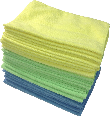Removing Grease from the Range Hood
Written by Lee Wyatt (last updated March 1, 2021)
While there are all kinds of tools and options available for preventing grease from getting onto your stovetop, the range hood always seems to be a different matter. Removing grease from the range hood takes a bit more effort than simply wiping it down. To really get the job done right, all you need to do is follow these directions.
- Turn off the power. Before you do any type of cleaning of the range hood, you should turn off the power to the kitchen. This will help prevent any possible electrical accidents from happening when you remove the hood. Turn the power off at the circuit breaker, then test the hood to ensure that the power has been successfully cut off.
- Remove the filter. Once you have cut off the power, go ahead and remove the filter. This can most often be done by removing the screws that hold the filter cover in place. Set them aside carefully so that you don't lose them.
- Inspect the filter. With the filter removed, you can now begin inspecting the filter itself. If the filter is a charcoal filter, simply dispose of it and replace it with a new one. However, for reusable filters, you will need to do a bit of cleaning. Set the filter aside for later.
- Remove the light cover. Take a look at the light cover and figure out how to remove it. Once it's removed, spray it with a degreasing agent, and allow it to soak for about 15 minutes.
- Clean the light cover. Using a clean rag or sponge, begin cleaning the light cover. You don't want to use something too harsh or you could end up scratching or damaging the cover. Simply scrub the cover using your favorite type of degreasing dish detergent and as little pressure as possible. When you have removed all the dirt and grime, set it aside to air dry.
- Clean the hood. While the light cover is drying, start cleaning the hood. Spray down the hood with a bit of degreasing agent to help break things up and prepare it for the deep cleaning. The best way to do this is by preparing one bucket of cleaning solution, and a second of clean warm water to rinse out the rag. In the cleaning bucket, pour some baking soda, water, and your favorite degreasing dish detergent. Use a rag and the cleaning solution to begin cleaning the hood. Periodically rinse out the rag in the clean water, and then dip it back into the cleaning solution and begin cleaning again. Continue, changing the water in your buckets as necessary, until the hood is clean. Allow the hood to air dry.
- Clean or replace the filter. While the hood is air drying, it is time to replace or clean your filter. First, rinse off the reusable filter and inspect it. If it requires a lot of cleaning, let the filter soak for a while so that it will be easier to scrub. Scrub the filter, removing as much of the grease and grime as possible. An option that requires less elbow grease for you is to stick it in the dishwasher by itself for a complete cycle.
- Dry and inspect. Allow everything you have cleaned to dry completely before you do anything else. Once everything has dried completely, take a good long look at all the various pieces and check to make sure they're all clean. If there are any bits and pieces that are not cleaned to your satisfaction, repeat the cleaning process to get it as clean as you would like it.
- Reassemble and test. Once you have all the parts cleaned, go ahead and reassemble your range hood. Be careful that you do it in the reverse manner of how you disassembled it. With everything reassembled, go ahead and turn the power back on and test the unit to ensure that it is working properly.
Be careful as you go about cleaning your range hood. If you are not careful, you can easily end up damaging something (really anything) that could cost an arm and a leg to replace. Beyond that, if you don't pay particularly close attention to where you put everything, you could lose some small item (such as a screw), which would make replacing everything really difficult.
Author Bio
Lee Wyatt
Contributor of numerous Tips.Net articles, Lee Wyatt is quickly becoming a regular "Jack of all trades." He is currently an independent contractor specializing in writing and editing. Contact him today for all of your writing and editing needs! Click here to contact. Learn more about Lee...
Home Decorating Ideas
One of the largest problems that people have when doing home decorating is that they tend to not really know what they ...
Discover More
Cleaning Silver-Plated Coffee Pots
If you are looking to add a little bit of elegance to your kitchen, then you can't really go wrong with some ...
Discover More
Preventing Mold from Growing on Siding
Mold and mildew are some fairly nasty things that can grow just about anywhere if the proper steps aren't taken. One of ...
Discover More
Cleaning the Range Hood Air Filter
While your range hood may only need to be cleaned every once in a while, something that needs to be attended to fairly ...
Discover More
Cleaning Stoves Quickly
If you have ever tried to clean a stove, then you know just how difficult it can be to clean them quickly. However, just ...
Discover More
Removing Burn Stains from Porcelain Range Tops
Second only to gas stoves in popularity, porcelain and other kinds of flat-topped ranges are a favorite among homeowners ...
Discover More

Comments